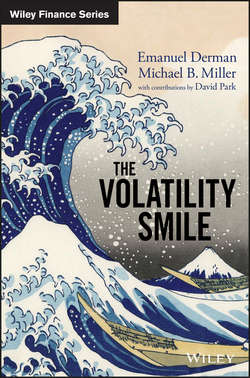Читать книгу The Volatility Smile - Park Curry David - Страница 10
На сайте Литреса книга снята с продажи.
Chapter 1
Overview
The Black-Scholes-Merton Model and Its Discontents
ОглавлениеStephen Ross of MIT, one of the inventors of the binomial option valuation model and the theory of risk-neutral valuation, once wrote: “When judged by its ability to explain the empirical data, option pricing theory is the most successful theory not only in finance, but in all of economics” (Ross 1987). But even this most successful of models is far from being perfect.
Finance academics tend to think of option valuation as a solved problem, of little current interest. But readers of this book who end up working as practitioners – on options trading desks in equities, fixed income, currencies, or commodities, as risk managers or controllers or model auditors – will find that the valuation of options isn't really a solved problem at all. Financial markets disrespect the traditional BSM formula even while they employ its flawed language to communicate with each other. Practitioners and traders who are responsible for coming up with the prices at which they are willing to trade derivative securities, especially exotic illiquid derivatives, grapple with appropriate valuation every day. They have to figure out how to amend the BSM model to cope with an actual market that violates its assumptions, and they have to keep finding new ways of doing so as the market modifies its behavior based on its experiences.
In this book we're going to focus on the BSM model and its discontents. In one sense the BSM model is a miracle: It lets you value, in a totally rational way, securities that before its existence had no plausible or defensible theoretical value at all. In the Platonic world of BSM – a world with normally distributed returns, geometric Brownian motion for stock prices, unlimited liquidity, continuous hedging, and no transaction costs – their model provides a method of dynamically synthesizing an option. It's a masterpiece of engineering in an imaginary world that doesn't quite exist, because markets don't obey all of its assumptions. It's a miracle, but it's only a model, and not reality.
Some of the BSM assumptions are violated in minor ways, some more dramatically. The assumption that you can hedge continuously, at zero transaction cost, is an approximation we can adjust for, as we will illustrate in later chapters. Skilled traders and quants do this with a mix of estimation and intuition every day. You can, for example, heuristically allow for transaction costs by adding some dollars to your option price, or some volatility points to the BSM formula. In that sense the model is robust – you can perturb it from its Platonic view of the world to approximate the messiness of actual markets.
Other BSM assumptions are violated in more significant ways. For example, stock prices don't actually follow geometric Brownian motion. They can jump, their distributions have fat tails, and their volatility varies unpredictably. Adjusting for these more significant violations is not always easy. We will tackle many of these difficulties in this book.
In the end, the BSM model sounds so rational, and has such a strong grip on everyone's imagination, that even people who don't believe in its assumptions nevertheless use it to quote prices at which they are willing to trade.
